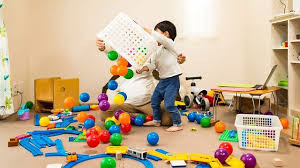
to
Where I grew up, kindergarten was half-day and I attended the afternoon session. I walked to school with a friend most of the time, but sometimes I walked alone. I clearly remember one of those alone days. It was warm, so it was probably towards the end of the school year. The neighborhood was quiet and peaceful. When I got to the school-yard, however, my route, which required walking through a large field of grass, was disrupted. Multiple sprinklers were on, watering the grass with large, overlapping arcs, while making that all-too-familiar tch-tch-tch sound. I knew I wasn't going to get to the other side of those sprinklers without getting soaked.
I considered my options. Here was what my little six-year-old brain came up with: I could run through the sprinklers and get to school dripping wet, but on time. Or I could backtrack and take the long way to school, through the otherside of the neighborhood. It would get me to class dry, but I would be late. I choose the latter. When my teacher asked me why I was late, I simply told her that the sprinklers were on in the field and I had to take the long way to school. She said she understood and that was that.
Not to toot my own horn, but I really like my six-year-old self. She was confident, pragmatic, and competent. Not once did she consider going home to ask Mom for help or a ride to school. She didn't panic. She wasn't stressed or overwhelmed. She just considered the situation, as well as the solutions, chose one and moved on.
When considering my childhood, this is probably the best example I can provide that illustrates, in a fair and honest way, what being a Gen X kid was like. Yes, we roamed the neighborhood until dark, engaged in play that, these days, many consider too risky, and we were often home alone, but we were highly capable for our age.
In the world of parenting, hindsight often shapes current practices. As modern parents, we frequently analyze the upbringing styles of previous generations to craft what we believe to be better environments for our children. One such critique has been leveled at the Generation X experience—those of us who grew up in the 1970s and 1980s. Often labeled as "latchkey kids," we enjoyed significant physical independence, which has often been misconstrued as a sign of neglect. This has spurred a cultural shift towards over-parenting that has lead to over-scheduled lives and little free time for today's children. So, as we critique past generations, it's crucial we understand the nuanced realities of past and present childhoods and distinguish between different types of childhood independence.
It's tempting to label the free-range approach of the 70's and 80's as neglectful, unsafe, or unwise. For many modern-day parents, doing so supports their over-involved, anxious approach. In actuality, that free-range approach cultivated development in the best ways. We know that childhood independence and free-play foster problem-solving skills, social skills, resilience, and self-reliance, to name a few. Nevertheless, despite all of this good, there was something missing for many Gen X kids - parental emotional availability.
The parents of Generation X were characterized by a 'silent strength' that prioritized survival and practicality over emotional expression. Societal norms at the time valued stoicism and self-reliance, leading to a legacy of emotional unavailability. Emotional availability wasn't a concern parents in the 70's and 80's were highly conscious of; instead, survival and providing materially were paramount.
In most cases, this was not due to neglect, but rather as a consequence of their parents’ upbringing. Keep in mind, members of this previous generation were raised by parents who lived through significant societal upheaval—marked by the Great Depression and two World Wars. These significant and extremely challenging events shaped their worldviews, making them practical, but emotionally reserved parents. Additionally, economic challenges, such as the oil crises and recessions throughout the 1970s, necessitated a significant increase in dual-income households, without a reliable day-care structure for parents to rely on.
So how have modern-day parents compensated for the lack of parental emotional availability in their own childhoods? More often than not, parents today have swung the pendulum too far in the opposite direction. And by doing so, these parents aren't any more emotionally available to their own kids, than their parents were to them. Over-scheduling a child's life and utilizing overprotective scrutiny and micromanaging every aspect of a child's emotional landscape is not parental emotional availability. Being emotionally available doesn't mean shielding a child from every possible adversity. It's not about removing every hurdle or challenge, while calmly talking to them about emotions. Parental emotional availability is not sparing a child from life's disappointments or creating a bubble-wrapped, activity-filled world for them.
Parental emotional availability is about fostering a relational atmosphere that lets a child know that they can come to their parent for support and guidance. It is being present. responsive, and empathetic in small ways throughout the day. It's about taking a moment to stop what you're doing, make eye contact with your child, and just listen and guide. It's not about ensuring you are present for every emotional moment, while talking deeply about emotions. It's about creating a safe haven in which your kid feels comfortable coming to you with their worries and concerns. It's about allowing your child to experience challenges and hardship. This is what fosters emotional independence in children.
For parents today, striking a balance between physical independence and emotional independence can be challenging. Parents experience immense pressure to keep up with everyone else. In the long run, the childhood rate-race is harming our children. But striking this important balance is possible. It's about slowing down and doing less. It's about encouraging free-play and independence without much adult supervision. It's about giving children the space to explore while being a reliable source of comfort and guidance. It's about encouraging dialogue and emotional expression, while letting our kids struggle and work through their hardships.
As we navigate the intricacies of modern parenting, let's appreciate the lessons from past generations without mislabeling their methods. We can learn so much from the free-range upbringing of Generation X, while also recognizing that today's parenting landscape permits new approaches. There are promising trends regarding parents' emotional engagement these days. As awareness grows about mental health and emotional well-being, many parents today actively seek to build healthy emotional connections with their children. We can, and we should, combine emotional availability with independence, crafting a nurturing yet empowering environment for our children. This delicate equilibrium supports their development in the most effective way, thus preparing them for the journey of adulthood.
**References:**
- Autor, D. H., & Dorn, D. (2013). *The Growth of Low Skill Service Jobs and the Polarization of the US Labor Market*. American Economic Review.
- Brussoni, M., Olsen, L. L., Pike, I., & Sleet, D. A. (2015). *Risky play and children's safety: Balancing priorities for optimal child development*. International Journal of Environmental Research and Public Health.
- Fraley, R. C., Roisman, G. I., & Haltigan, J. D. (2013). *The legacy of early experiences in development: Formalizing alternative models of how early experiences are carried forward over time*. Child Development.

It's a heavy, uncomfortable feeling, that moment when we realize we've made a mistake. In that moment, we have choices. We can choose to over-engage with that experience and step into shame-based thinking and avoidance, or we can apologize, Yes, it's usually as simple as that. Utilizing an authentic apology is not only a necessary and effective relational tool, it's also a useful form of self care.
As parents, we often strive to be "perfect" role models for our children. Yet, just like everyone else, we’re not immune to making mistakes. Whether your children are still at home or have grown into adults, one of the most powerful ways you can demonstrate love and respect is by acknowledging your errors and making amends. Apologizing and attempting to repair relationships is not just beneficial—it’s essential, and it's never too late to start.
Why Apologizing Matters
1. Modeling Accountability: Apologizing to your children, regardless of their age, teaches them the importance of taking responsibility for their actions. This lesson is crucial for both their personal and relational development.
2. Building Trust: Honesty and vulnerability engender trust. When you apologize sincerely, you show your children that you value the relationship enough to own up to your mistakes.
3. Emotional Healing: Apologizing can be profoundly healing for both you and your child. It allows wounds—whether recent or decades old—to begin to heal, fostering a healthier emotional landscape for everyone involved.
Tips for Apologizing to Younger Children:
1. Get Down to Their Level: Physically lowering yourself to eye level can make the apology more sincere and direct.
2. Use Simple Language: Kids respond better to straightforward, age-appropriate language. Avoid complicating the apology with too many details.
3. Acknowledge Their Feelings: Saying something like, "I understand that when I raised my voice, it scared you. I'm really sorry," helps them feel seen and heard.
4. Allow the Apology to Stand Alone: Avoid redirection or pointing out what the child did that contributed to your frustration. Make sure the child always knows your emotions are not their fault or responsibility.
Tips for Apologizing to Adult Children:
1. Be Sincere and Specific: A heartfelt apology should clearly state what you’re apologizing for. Avoid vague statements like, “I’m sorry for everything.”
2. Validate Their Experience: Acknowledge their feelings and experiences without being defensive. For instance, "I didn't fully understand how my actions affected you, and I deeply regret it."
3. Focus on Repair and Growth: Offer actionable steps to repair the relationship and demonstrate a commitment to change. This could be through regular communication, therapy, or simply making an effort to be more supportive.
4. Accept Your Adult Child's Response: Apologizing is you taking responsibility for you. It's not a guarantee that your relationship will improve.
Studies in adult development, such as those by renowned psychologist Erik Erikson, highlight the importance of reflecting on past actions in later stages of life. Erikson's theory suggests that meaningful relationships and generativity—making amends and leaving a positive legacy—are vital components of a fulfilling life. Apologizing is a powerful way to foster these elements in your relationship with your children, regardless of their age.
Dr. Robert Kegan’s work on adult development also emphasizes the concept of evolving self-identity. Apologizing and repairing relationships can be a transformative experience that contributes to both emotional and cognitive development.
By openly embracing the power of an apology, you create a legacy rooted in love, humility, and growth. It's never too late to apologize and make amends. Whether it’s a heartfelt conversation over coffee with your adult child or a gentle word with your little one before bed, the act of apologizing can significantly strengthen your relationship, as well as your positive sense of self.
What have you found most challenging about apologizing? Share your thoughts in the comments below!

Years ago, our move to Florida brought with it a few adjustments, including the way our kids played. We left behind a classic 'playborhood', where kids would gather outside every day and ride bikes and scooters, play tag and sports, without much adult supervision. When we started planning our move, it didn't cross our minds that not all neighborhoods were 'playborhoods''. We did our research and learned that there were numerous kids in the area, and a lot of the yards were home to play gyms or trampolines. The neighborhood we choose even had its own playground and tennis and basketball courts.
Once there, however, we noticed the neighborhood was consistently desolate of kids playing outside. I started reaching out to parents and learned that peer play-time was almost always scheduled and supervised by parents. This is how I learned the term 'play-date'. And finding time to play with these very busy and very scheduled kids wasn't easy. So our boys played a lot with each other. We encouraged them to play outside and designated an area of the house for their play. This play space was often scattered with legos, lightsabers, and hot wheels. But it was their space and play they did. Once a family friend was over for dinner. After dinner, the boys left to play and the three of us sat outside talking. At one point our friend interrupted the conversation and stated that he just needed to make sure "this was normal". He was referring to the loud ruckus the boys were making. My husband and I hadn't even noticed it. We assured him it was very normal.
As parents, the sight of toys scattered across the room and the constant background noise of shrieks, giggles, stomping and loud voices, can be overwhelming. It’s easy to feel stressed when your home transforms into what appears to be a disorderly jungle gym. However, amid this mess lies the profoundly valuable chaos of play. When parents attempt to remove the chaos of play from their lives, they are inadvertently disrupting the development of their child. Children who lack regular free-play are at risk for increased worry and anxiety and are often less tolerant of the world and it's challenges. Not enough physical activity can disrupt sleep patterns and focus as well.
Here's how your kids benefit from the chaos of play:
Play is a fundamental part of childhood learning. Through imaginative play, children develop critical thinking and problem-solving skills. Whether they are building complex structures with blocks or engaging in make-believe scenarios, play stimulates brain development and helps children learn to plan, communicate, and execute their ideas.
Playing with others teaches kids how to interact socially. They learn the importance of sharing, negotiation, and empathy. These interactions help them build the foundation for strong relationships in the future. Those pretend tea parties and collaborative LEGO castle constructions are more than just passing the time—they're essential social skill-building exercises.
Play allows children to express their feelings and work through emotions in a safe environment. Dramatic play scenarios can help kids process what they experience in real life, including fears and anxieties. This emotional rehearsal builds resilience and emotional intelligence for the real challenges of life.
From climbing playground structures to running around the yard, physical play is crucial to a child's health. It enhances motor skills, coordination, and overall physical fitness. In a world where screen time is steadily increasing, encouraging active play is more important than ever.
Unstructured playtime fosters creativity. Give a child a cardboard box, and suddenly it becomes a spaceship, a fort, or a submarine. This ability to think outside the box (literally and figuratively) is a vital skill that will benefit children in all areas of life.
Accepting and even celebrating the chaos of play can change your perspective as a parent. Here are some tips for managing the stress that often accompanies a playful home. Embrace the mess by:
Establishing specific areas in your home where play is encouraged. This can help contain the mess and make clean-up more manageable. A well-organized play zone can still be full of activity without overtaking your entire living space.
While it's important to allow unstructured playtime, setting limits on when and where certain types of play can happen can help maintain a sense of order. Establishing routines for tidying up can also teach your child responsibility and the importance of cooperation.
Instead of focusing on the disorder, try to see the creativity and learning happening within the chaos. Remind yourself that this phase of life is temporary, and the day will come when the toys are gone, and the house is quiet.
Here's the takeaway: The chaos of childhood play may seem like a storm in your living room, but it is also a whirlwind of learning, growth, and joy. By recognizing the immense value of play, as a parent you can cultivate an environment that nurtures your child's development while maintaining your own peace of mind. Embrace the chaos, and remember that the world of play is the work of childhood.

We've all been there. One moment your teen is asking politely for an extra hour of screen time, and the next, it feels like they are employing every trick in the book to bend the rules. It's easy to label such behavior as manipulation, but have you ever wondered what's really going on with your teenager in these moments? There's more there than you might think.
Teenagers are in a fascinating phase of growth and discovery, both physically and emotionally. Their attempts at persuasion, negotiation, and, yes, what sometimes feels like manipulation, are often part of a broader developmental journey.
Let's pull back the curtain to better understand what's really happening behind the scenes.
Cognitive Development: Testing Limits and Boundaries
Adolescence is a critical period for cognitive development. During these years, teens are honing their reasoning skills and beginning to think more abstractly. When they argue their case for extending curfews or skipping chores, they’re not just trying to wear you down—they're practicing the art of negotiation and learning the nuances of cause and effect.
Emotional Growth: Seeking Independence
Every teenager yearns for independence; it’s a natural part of growing up. What appears to be manipulation might instead be developmental steps towards asserting their autonomy. They are learning to express their desires, whether it's about making their own decisions or seeking more privacy. While it’s essential to set boundaries, recognizing this quest for independence can provide a balanced perspective on their behaviors.
Social Skills: Understanding Relationships
Teenagers are navigating the complex web of social interactions. When they attempt to influence you, they are also testing and refining their social skills. Understanding hierarchy, empathy, and effective communication are part of this equation. They’re learning what works, what doesn’t, and what crosses the line—key lessons that will serve them well in adulthood.
Emotional Regulation: Mood Swings and Stress Management
Adolescents often experience intense emotions and mood swings due to hormonal changes and brain development. Their mood might shift from joy to frustration within minutes, leading to behaviors that seem manipulative. Recognizing these emotional roller coasters can help you approach the situation with empathy and patience.
The Science of the Teenage Brain
Lastly, the teenage brain is still under construction. The prefrontal cortex, responsible for decision-making, impulse control, and understanding long-term consequences, isn't fully developed until the mid-20s. This biological fact means that teenagers are still learning how to make well-thought-out decisions and manage their impulses.
Tips for parents during these developmentally rich moments:
1. Set Clear Boundaries: Clear, consistent rules help teens understand expectations and the consequences of their actions.
2. Communicate Openly: Foster an environment where your teen feels safe to express their feelings and thoughts without fear of immediate judgment.
3. Offer Choices: Giving teenagers choices helps them feel empowered and teaches them to take responsibility for their decisions.
4. Model Behavior: Demonstrate the kind of respectful and open communication you expect from them. Don't take their behaviors personally.
5. Stay Involved: Be a part of their lives, showing interest in their activities and friendships.
While it might feel like teenagers are masters of manipulation, it's crucial to remember that these behaviors are often rooted in their developmental needs. By understanding the underlying causes, parents can better navigate these challenging, yet rewarding years. and not take their child's behavior personally. With patience, empathy, and clear communication, you can effectively guide your teenager towards their next stage of development - adult development.
Keep nurturing, keep understanding, and remember—you’re doing an amazing job. Your efforts today will pay off!








